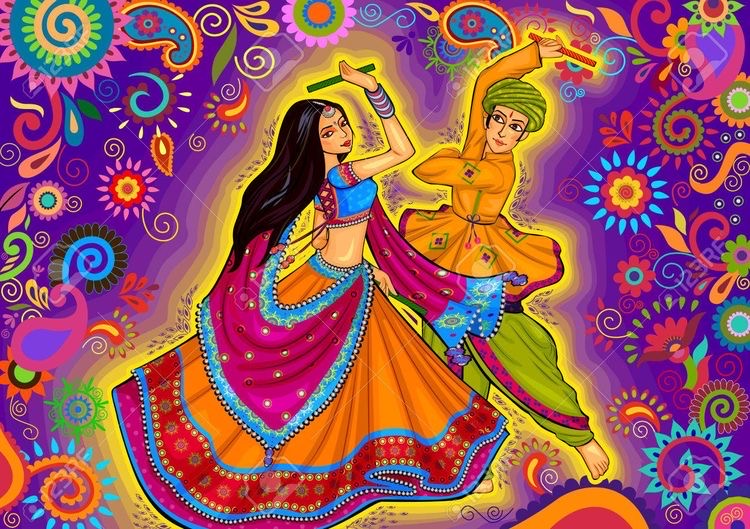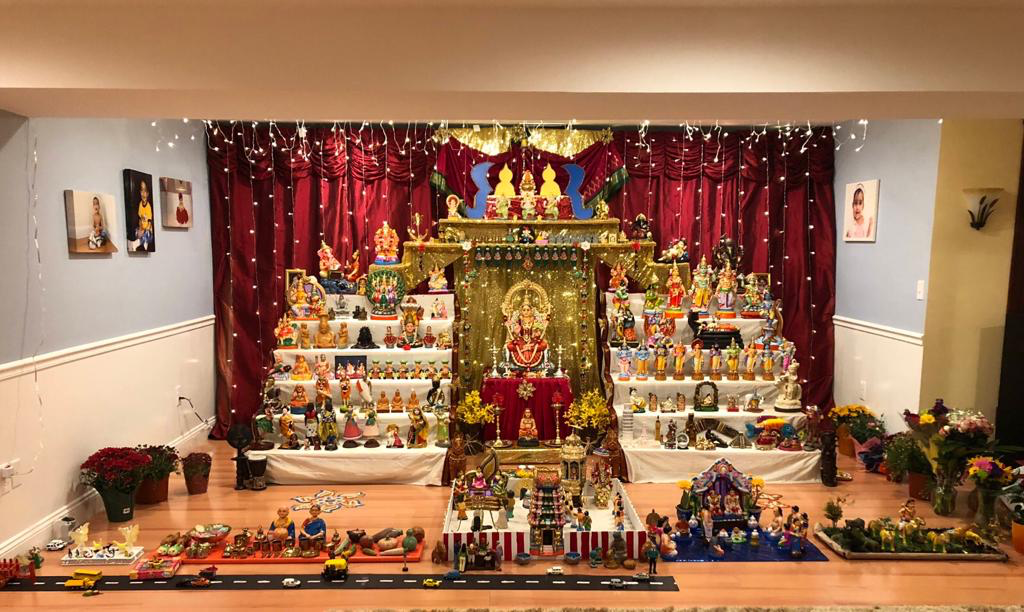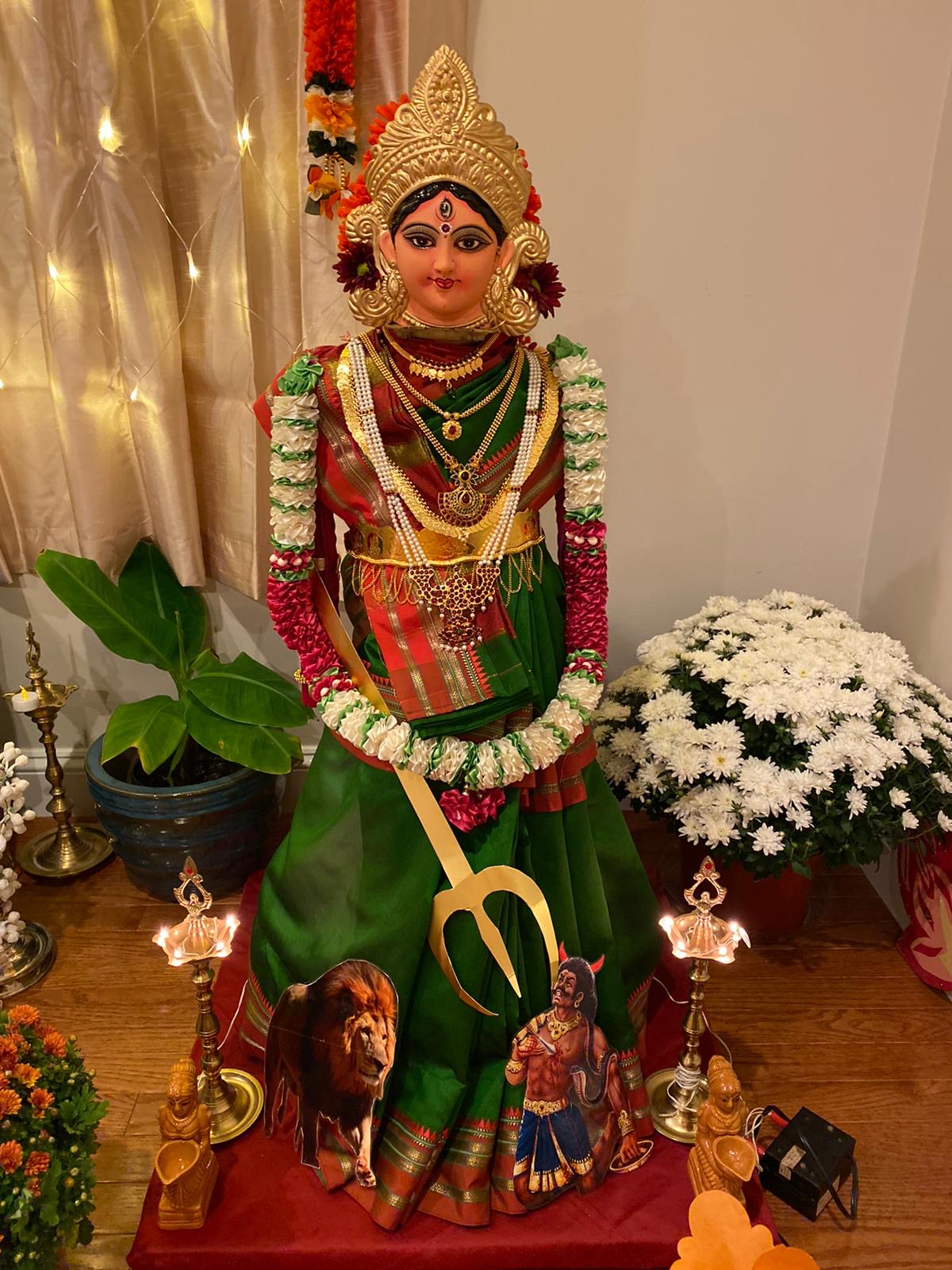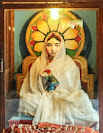
The arena was bustling with energy; echoing with youthful chatter and laughter over the lively garba music and the rhythmic beats of dandia. College students of all ethnicities were dressed in finest kurtas, lehengas, ghagras and chaniya-cholis, dupattas and shawls in exotic designs. The colors and patterns were so brilliant that it felt like they had borrowed the vibrant autumn hues of reds, yellows, oranges and the remaining bit of green from the New England Fall outdoors and added to their already spectacular palette! Beautiful young students dancing and twirling and maneuvering the two large concentric circles, their prettified dandiya sticks matching the beats as they moved gracefully around a majestic image of Goddess Durga slaying the demon Mahishasura. The scene reminded me of my teenage years - different country, different generation, different population - yet the same nine magical nights of Navratri!

The chilly, yet festive evening was a reminder that colder weather and shorter days signal the beginning of the holiday season and festivals in many cultures. For Indians, autumn brings the first celebration of the season with Navratri, a nine night festival (nav means nine, ratri means night) honoring nine manifestations of the Goddess Shakti or Durga. It is celebrated in special ways in different parts of India. In western India it is celebrated with Garba and Dandiya dancing, in eastern India it is celebrated as Durga Pujo, in southern India with Golu, Koluvu or Habba figurine decorations, and in north India with Ashtami Pooja as a special honor for young girls meant to represent the Goddess Shakti (or energy) on Earth.
We have been fortunate to be a part of a cosmopolitan culture that introduced us to the variety of ways of celebrating holidays, including Navratri. Durga Pujo from eastern India is a five day festival which starts on the sixth day of Navratri and ends on the tenth day, called Vijayadashmi. The main Goddess revered (in the middle in the Pujo picture above) is Parvati with her children, the Goddesses of Wealth (Lakshmi) and Knowledge (Saraswati) on each side, and on far two sides are Ganesha (the god of good beginnings), and Kartikeya (the god of war). Our connection with the culturally active Bengali community is through their plays and theatre in which our friends (pictured left) play an active role. Pujo plays incorporate progressive themes around Goddess Durga.



In the South Indian tradition, friends invited us to get blessings from Goddess Durga and visit the Golu or Koluvu decorations. The dolls decorated on the steps of Golu/Koluvu have fascinating stories. Some dolls have been passed down for generations; others added new every year. Some depict incarnations of favorite deities; others display stories. Some are traditional; others modern. There are nature scenes, harvest scenes and animals. There is sometimes a theme like the one I visited was designed like an Indian flag. Besides the fun decorative dolls and scenes, the other fun aspect of this tradition is guests dressing up in the traditional Indian sarees and jewellery, in shades of the auspicious color of that day, and getting together for an evening of singing, dancing, gossip, prasadam of sundal (pulses) and other goodies, and lots and lots of pictures! Now we reminisce and are grateful for the pre-covid grandeur of festivities, and spend this year praying for return to normalcy.

Navratri cannot be complete without the North Indian tradition of a special celebration on the eighth or the ninth day for little girls. For at least a decade, in our home away from home, a group of friends in our community in the US, have made this day iconic for us all. They invited the girls and their Moms, prepared special food consisting of Halwa-Puri-Chana, gifted the girls special treats and performed a ceremony to mark the girls as the feminine power representing the Goddess. The little girls in our community grew up knowing about and being grounded in this tradition, with Navratri and especially “Ashtami” being a very special day, as a friend very aptly put in her article. Older and wiser, the girls now ask about Goddess Durga, and her significance. Durga (Shakti) assumes various forms that manifest strength and courage to confront and transform whatever demon she faces.

There are so many fun ways to celebrate Navratri, yet each one has a common theme - that of the victory of the powerful Goddess Durga over the demon Mahishasura; one profound, empowering message symbolizing the victory of good over evil. The story is supposed to have happened about 1.3 billion years ago. One may question the timeline, though the story is uplifting with Durga projected as the epitome of an empowered woman. The demon Mahishasura underestimates the capacity of a woman to kill him. Of course no such woman exists on earth, so a warrior woman was created - conceivable of raising a modern day, empowered young girl to achieve her full potential. I believe the Goddess’ multiple arms indicate her being multi-talented and her skill with specialty weapons that are gifted to her. Having a lion as a vehicle symbolizes that she has already tamed the ferocious animal who would assist her in battle. The demon being a shapeshifter, it wasn’t some easy peasy battle either, which went on for more than nine days. Ultimately, this all powerful demon, with a boon that he could not be killed by a man, was slayed by the all powerful woman.

Beyond the symbolism, I can’t help but appreciate the path that the festival of Navratri, and the strength of this powerful Goddess, carves for all the women and girls who believe they too can stand up to any demons that present themselves in the form of constant challenges. Every once in a while we come across women, real life Durgas, who take the extra steps to conquer the demons around and within, with strength, fortitude and courage. It fills my heart with pride and hope to see elements of Goddess Durga in real women around me!









Comments
Post a Comment